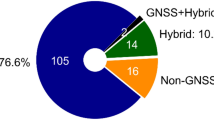Abstract
In this paper, an autonomous relative navigation and joint attitude determination algorithm in asteroid exploration descent stage is researched based on feature point information of perpendicular asteroid surface image observed by optical navigation camera, distance vectors from spacecraft to asteroid measured by three angled installed lidars and relative velocity increment measured by accelerometer when the relative distance vector to the centroid of asteroid can not be obtained. The inertial attitude of spacecraft is determined by sun vector, star vectors and inertial angular velocity respectively measured by sun sensor, star trackers and inertial reference unit. Also, in order to obtain measurement error model transferred from sensor noise, a covariance matrix solver considering error correlation is presented via the error model of normalized vector to first order. Numerical simulation and improved observability evaluation of filtering are undertaken to discuss the results of complete sensor observation and weak observation of lidars, and verify the effectiveness of the presented relative navigation and attitude determination algorithm.
Similar content being viewed by others
References
Li S, Cui P Y. Landmark tracking based autonomous navigation schemes for landing spacecraft on asteroids. Acta Astronaut, 2008, 62: 391–403
Farquhar R W, Dunham D W, McAdams J V. Near mission overview and trajectory design. J Astronaut Sci, 1995, 43: 353–371
Dunham D W, Farquhar R W, McAdams J V, et al. Implementation of the first asteroid landing. Icarus, 2002, 159: 433–438
Kubota T, Hashimoto T, Sawai S, et al. An autonomous navigation and guidance system for MUSES-C asteroid landing. Acta Astronaut, 2003, 52: 125–131
Fuyuto T, Naoko O, Kenji O, et al. Image based navigation and guidance for approach phase to the asteroid utilizing captured images at the rehearsal approach manuscript template and style guide. In: the 61st International Astronautical Congress, Prague, 2010. 1–8
Kubota T, Hashimoto T, Kawaguchi J. Vision based navigation by landmark for robotic explorer. In: Proceedings of the 2008 IEEE International Conference on Robotics and Biomimetics, Bangkok, 2009. 1170–1175
Kubota T, Hashimoto T, Kawaguchi J. Guidance and navigation of hayabusa spacecraft for asteroid exploration and sample return mission. In: SICE-ICASE International Joint Conference, Busan, 2006. 2793–2796
Miso T, Hashimoto T, Ninomiya K. Optical guidance for autonomous landing of spacecraft. In: IEEE Trans Aerosp Electron Syst, 1999, 35: 459–473
Zhao Z J, Zhao J D, Liu H. Study on the landing mechanism employed in asteroid exploration. In: Proceedings of 2012 IEEE International Conference on Mechatronics and Automation, Chengdu, 2012. 1032–1037
Alexander J, Cheng Y, Zheng W, et al. A terrain relative navigation eensor enabled by multi-core processing. In: IEEE Aerospace Conference, Pasadena, 2012. 1–11
Cui P Y, Zhu S Y, Cui H T. Autonomous optical navigation and guide method for soft landing on small bodies. J Astronaut, 2009, 30: 2159–2164
Huang X Y, Cui H T, Cui P Y. An autonomous optical navigation and guidance for soft landing on asteroids. Acta Astronaut, 2004, 54: 763–771
Gao A, Cui P Y, Cui H T. Research on optical/inertial integrated navigation for soft landing on asteroids using mixed H2/H∞ filter. In: International Conference on Intelligent Control and Information Processing, Dalian, 2010. 20–23
Fu M Y, Deng Z H, Zhang J W. Kalman Filtering Theory and its Application in Navigation System. Beijing: Science Press, 2003. 17–22
Van der Merwe R, Wan E A, Julier S I. Sigma-point Kalman filters for nonlinear estimation and sensor fusion: applications to integrated navigation. In: AIAA Guidance, Navigation, and Control Conference and Exhibit, Providence, 2004. 1–30
Shuster M D, Oh S D. Three-axis attitude determination from vector observations. J Guid Control, 1981, 4: 70–77
Hong S Y, Chun H H, Kwon S H, et al. Observability measures and their application to GPS/INS. IEEE Trans Veh Technol, 2008, 57: 97–106
Deng Z L, Wang X, Gao Y. Modeling and Estimation. Beijing: Science Press, 2007. 74–78
Rossi A, Marzari F, Farinella P. Orbital evolution around irregular bodies. Earth Planets Space, 1999, 51: 1173–1180
Li K, Lin L X. Optimal maneuver control of spacecraft formations in eccentric reference orbits. J Astronaut, 2008, 29: 760–764
Mukai T, Araki H, Mizuno T, et al. Detection of mass, shape and surface roughness of target asteroid of MUSES-C by lidar. Adv Space Res, 2002, 29: 1231–1235
Author information
Authors and Affiliations
Corresponding author
Rights and permissions
About this article
Cite this article
Ma, H., Chen, T. & He, Y. An algorithm and observability research of autonomous navigation and joint attitude determination in asteroid exploration descent stage. Sci. China Inf. Sci. 57, 1–17 (2014). https://doi.org/10.1007/s11432-014-5091-y
Received:
Accepted:
Published:
Issue Date:
DOI: https://doi.org/10.1007/s11432-014-5091-y




